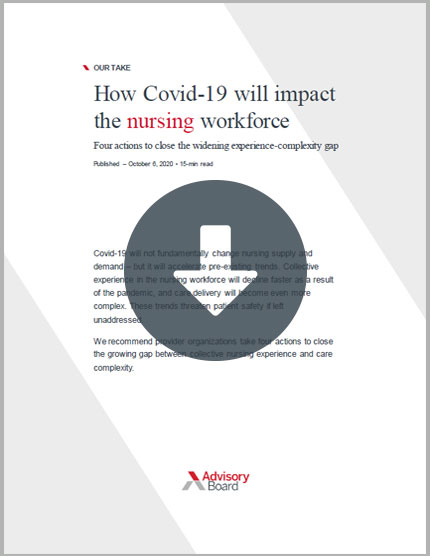Auto logout in seconds.
Continue LogoutMedscape last month released its annual APRN Compensation Report, which highlights trends in APRN compensation in 2019 and offers insights into how ARPNs have been affected by the novel coronavirus pandemic.
Nurse Manager Portal: Our top resources for nurse managers
Report details
For the report, Medscape surveyed 3,294 APRNs, including 2,002 NPs, 500 clinical nurse specialists (CNSs), 401 nurse midwives (NMs), and 391 certified registered nurse anesthetists (CRNAs).
Medscape wrote that it has been surveying APRNs about compensation trends for six years, and this year, "it was evident that the [novel coronavirus] pandemic that began a few months before [this year's] survey had dramatically altered the professional lives of many APRNs." For example, Medscape wrote, "[s]ome [ARPNs] were furloughed, some lost their jobs, and some pivoted to entirely new areas of practice."
In response to those changes, Medscape added questions to this year's survey asking participants how the pandemic had affected them.
How much APRNs make
Overall, Medscape found that compensation for APRNs in all four categories—CNSs, CRNAs, NMs, and NPs—increased in 2019 over 2018, and that annual compensation for all APRN categories represented in the survey were higher, on average, than the annual compensation of RNs.
CRNAs were the highest-paid APRNs in 2019, with an average annual income of $202,000, while CNSs were paid the lowest, with an average annual income of $107,000. Medscape also found that at least 60% of each APRN subgroup said they felt they were compensated fairly.
Medscape also found that CRNAs and NPs who were paid hourly made more, on average, than those who were salaried, while CNS who were paid hourly made less, on average, than those who were salaried.
Compensation for NPs varied by practice setting, Medscape found. NPs working in inpatient care settings in hospitals made the most, at an annual average of $122,000, while NPs working in public health/community health settings made the least, at an annual average of $108,000.
Compensation for NPs also varied by advanced practice certification. According to the report, NPs with a pediatric primary care certification made the least, while NPs with an adult gerontology acute care certification made the most.
Medscape also found that the gender pay gap persisted among NPs and CRNAs, which were the only APRN subgroups for which Medscape had enough data to analyze differences in pay by gender. According to the report, male NPs were paid 8% more than their female counterparts, while male CRNAs were 15% more than female CRNAs.
Further, Medscape found significant pay differences among APRNs by region. The Pacific region had the highest average annual compensation for APRNs in 2019, for instance, while the East South Central region had the lowest.
How the coronavirus pandemic has affected APRN employment
Medscape also asked APRNs who said they were not currently employed whether their unemployment stemmed from the novel coronavirus pandemic. According to the report, 20% of unemployed APRNs said they were no longer working because of the pandemic. Among those respondents,12% said the pandemic led them to retire earlier than they had originally planned (Stokowski et. al., Medscape APRN Compensation Report 2020, 11/20).
Covid-19 will not fundamentally change nursing supply and demand but it will accelerate pre-existing trends. Collective experience in the nursing workforce will decline faster as a result of the pandemic, and care delivery will become even more complex. These trends threaten patient safety if left unaddressed.
We recommend provider organizations take four actions to close the growing gap between collective nursing experience and care complexity.
Don't miss out on the latest Advisory Board insights
Create your free account to access 1 resource, including the latest research and webinars.
Want access without creating an account?
You have 1 free members-only resource remaining this month.
1 free members-only resources remaining
1 free members-only resources remaining
You've reached your limit of free insights
Become a member to access all of Advisory Board's resources, events, and experts
Never miss out on the latest innovative health care content tailored to you.
Benefits include:
You've reached your limit of free insights
Become a member to access all of Advisory Board's resources, events, and experts
Never miss out on the latest innovative health care content tailored to you.
Benefits include:
This content is available through your Curated Research partnership with Advisory Board. Click on ‘view this resource’ to read the full piece
Email ask@advisory.com to learn more
Click on ‘Become a Member’ to learn about the benefits of a Full-Access partnership with Advisory Board
Never miss out on the latest innovative health care content tailored to you.
Benefits Include:
This is for members only. Learn more.
Click on ‘Become a Member’ to learn about the benefits of a Full-Access partnership with Advisory Board
Never miss out on the latest innovative health care content tailored to you.

